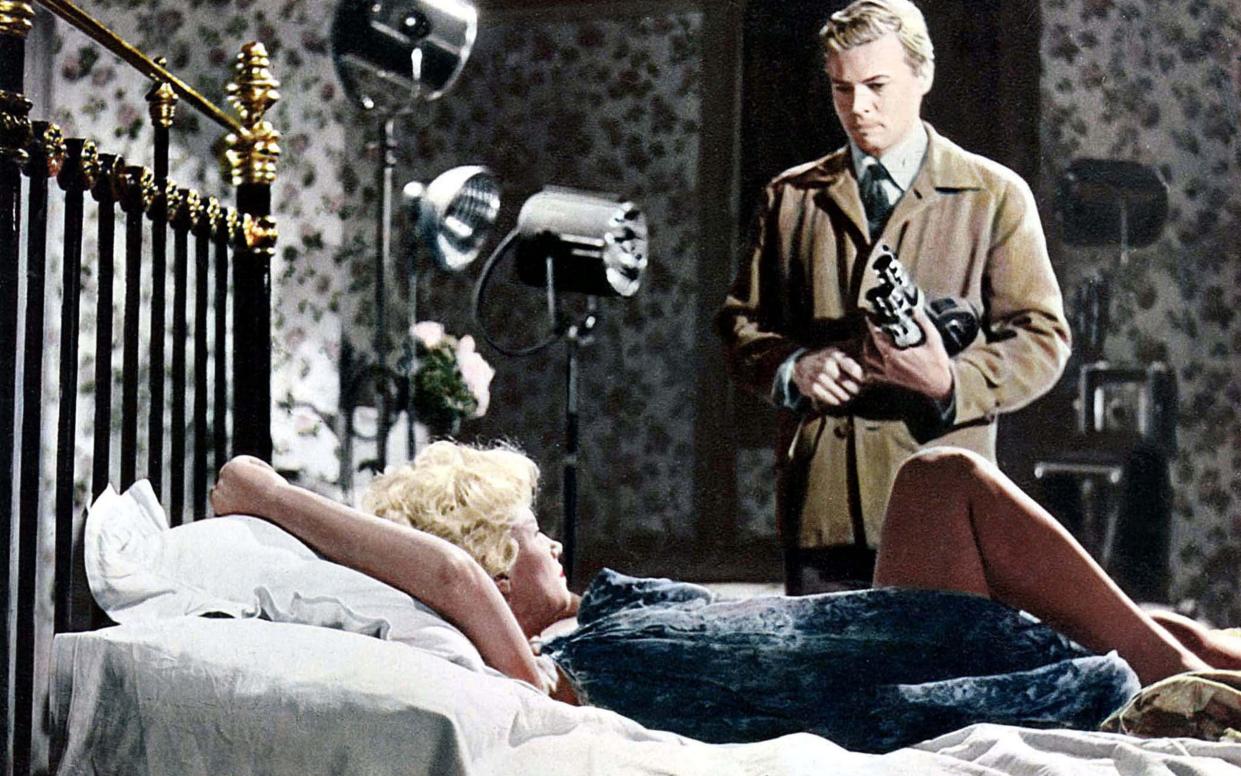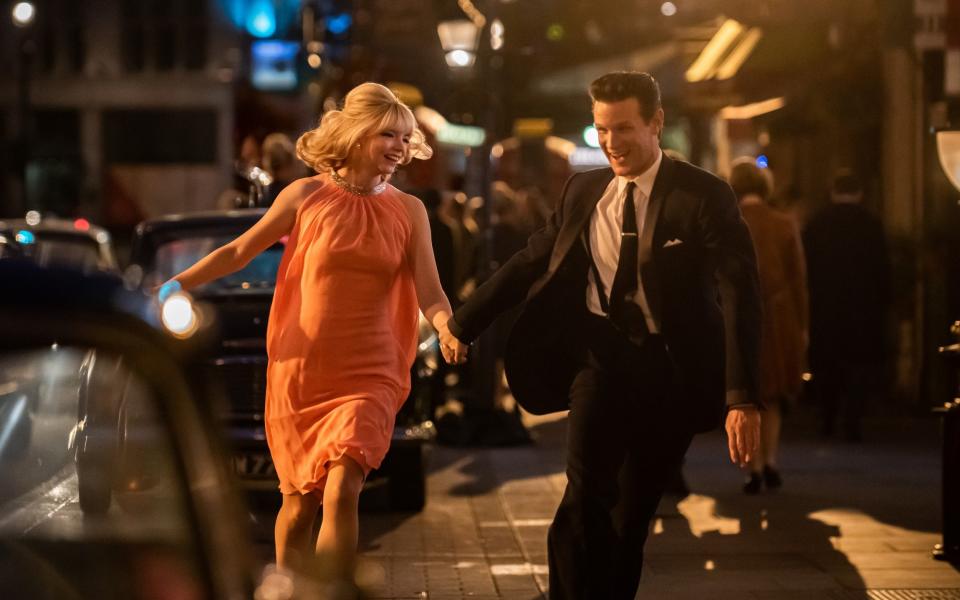Schlock horror: British cinema's dirty little secret

Edgar Wright’s new film Last Night in Soho begins as a fairytale and ends as a nightmare. It follows Eloise (Thomasin McKenzie), a Sixties-besotted fashion student, who moves to London to become a designer. She’s a loner, an oddball “country mouse” who is toyed with by her catty fellow students at UAL.
In an early scene, she falls asleep in the top-floor bedroom of a rackety bedsit she has rented to escape them. Seconds later, in a moment which is neither a dream or a vision, she wakes up, and, as the strains of Petula Clark’s Downtown swell, she emerges into the swirling lights of Swinging Soho, 60 years ago. And so the film becomes a cracked hall of mirrors where past and present, reality and fantasy, splinter together.
As a director, Wright is never coy about his influences. But Last Night is his most densely referenced film to date. From Psycho’s upraised knife and stabbing strings to Arnold Miller’s West End Jungle, a lurid 1961 documentary about Soho prostitution, it’s as much concerned with auteurish fistbumps as it is entertainment.
Above all though, Last Night owes a debt to a wave of British films of the late Fifties and early Sixties. Fusing psychological depth with schlocky thrills, films like Michael Powell’s Peeping Tom and Seth Holt’s The Taste of Fear rattled the cinematic establishment. Critics were scandalised; audiences enthralled. The psychological horror was born.
The seeds of this new genre were planted in 1951, when the X certificate was first introduced by the British Board of Film Censors. On paper, it was designed to protect innocent eyes under the age of 16; in reality, it acted as a come-on to eager directors, and had audiences licking their lips.
Many films advertised their transgressive kicks with prominent ‘Xs’ in the title or posters. In particular, Hammer Horror took advantage of this new license; following the success of The Curse of Frankenstein (1957) and Dracula (1958), the studio churned out dozens of campy supernatural flicks, drenched in Technicolor blood splats. Audiences, who had previously been moving away from the cinema in favour of television, lapped it up.

“A new sort of brutality emerges in the early Sixties,” argues the author and broadcaster Matthew Sweet. “And it wouldn’t have happened without the reform of the certification system because that allowed this appetite to be fed in a really direct and satisfying way.”
Few, though, were prepared for the impact of Michael Powell’s voyeuristic thriller Peeping Tom when it arrived in 1960. “[It is] the sickest and filthiest film,” spluttered The Spectator. The Daily Worker judged it: “Wholly evil. Shovel it up and flush it down the nearest sewer.” Written by Leo Marks, it stars Karl Boehm as Mark, a shy, lonely young man who works as a film studio focus-puller while moonlighting as a photographer for Soho’s good time girls. He is also crafting a “documentary” - a snuff film in which he murders women with a knife concealed in a camera tripod, recording their final moments. In an awful twist, it’s revealed this camera also has a mirror which reflects back the victim’s terror. They see their own deaths: film watching as fatal entertainment.
As in Last Night in Soho, Peeping Tom is drenched in the language of cinema. In its opening shots, we see through Mark’s viewfinder as he carries out his first murder. Later, it transpires Mark was traumatised as a boy by his Skinner-esque psychologist father who subjected him to frightening experiments, filming his reactions. Extraordinarily, Powell himself plays Mark’s father in these eerie home movies, directing his son’s torment.
“It’s very much about the dangerous side of cinema,” explains Professor Charles Barr, Emeritus Professor of Film at the University of East Anglia. “The camera is an aggressive weapon. It was so exciting because it gave audiences a range of transgressive thrills which weren’t available in the Fifties.”

Yet Peeping Tom proved ahead of its time. It destroyed the career of Powell who, alongside his collaborator Emeric Pressburger, had been the darling of British cinema. Audiences weren’t prepared for its morally troubling gaze: in it, we’re voyeurs as much as its slasher protagonist. It leaves you feeling icky, and hopelessly complicit. “On the one hand, it’s commercial entertainment,” says Darrell Buxton, author of The Shrieking Sixties: British Horror Films 1960-1969. “But Powell is also pulling the wool over the eyes of his cast and audience by getting all this traumatic stuff out there on screen.”
Despite its critical lashing, Peeping Tom spawned a host of imitators. Some, such as Michael Reeves’s The Sorcerers (1968), which starred Boris Karloff as a mesmerist controlling a Mod teenager to commit murders, leant into Powell’s meta-cinematic high-jinks. Others, such as the string of films knocked out by Jimmy Sangster for Hammer and cashing in on the success of Psycho (which was released a few months after Peeping Tom, proving the Brits were slightly ahead of the game) simply luxuriated in the hysteria and gore.
Featuring an implausibly large cast of psychologically disturbed murderers, the B-movie stylings of these flicks were signalled by their one-word titles: Paranoiac (1963), Maniac (1963), Hysteria (1965). Often starring a young woman in peril, who is menaced by a baby-faced creep, the extreme psychological horror inherent in both these strands cut across cinematic audiences.
“They were films which appealed to the chain-knit sweater, chin-stroking crowd,” says Sweet. “But also to the single men in anoraks at the back.”
After the Sixties, psychological horror fell out of fashion. Films such as Hammer’s lesbian vampire trilogy (beginning with 1970’s The Vampire Lovers) promised harder, more explicit thrills. However, the once-detested Peeping Tom was given a new lease of life thanks to reappraisals by critics such as David Pirie whose Heritage of Horror - the first serious scholarly treatment of horror films - acclaimed it as a masterpiece.
Meanwhile Martin Scorsese, who as a cinéaste scamp hopped subways with his buddies to catch illicit screenings, declared that the film, alongside Federico Fellini’s 8 1/2, contained all there was to know about directing. His 1991 Cape Fear is a homage to Powell’s vision of a cracked soul in murderous torment.
But the roots of psychological horror are, and remain, British. As a genre, it emerged out of the pressure-cooker class system of the post-war period; a little cathartic bloodshed was the only proper disinfectant for a society that was, for the most part, a little grey and repressed.
But does its appeal run deeper still? Its popularity among contemporary British filmmakers suggests so. From Peter Strickland’s Berberian Sound Studio (2012) to Rose Glass’s Saint Maud (2019), psychological horror’s cocktail of jangling tension and barely-lidded violence seems to catch at a fundamental chink in the British psyche. “It illustrates a strand of sleazy hypocrisy in the British soul,” notes Sweet. “There’s this dirtiness about British cinema. We love it, and it says something rather alarming about our character.”
Last Night in Soho is in cinemas now. Edgar Wright’s London After Dark, a season of films which inspired the film, is at BFI Southbank until 30 November, with selected films available to stream on BFI Player.


